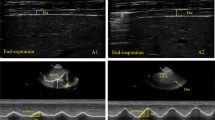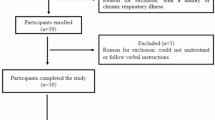Abstract
Study design:
This was an observational, descriptive case-series study. The magnitude and direction of diaphragm movement during tidal and maximal inspiratory breaths in tetraplegic subjects were measured using B-mode sonography on a single occasion. Data were tabulated for descriptive analysis.
Objective:
There is a paucity of literature reporting dynamic movements of the paralyzed diaphragm. The aim of this pilot study was to investigate and record diaphragm movement in subjects with a cervical spinal cord injury (C1–C5), which had resulted in tetraplegia with partial or complete diaphragm paralysis. Subjects were patients of the Royal Adelaide Hospital in South Australia.
Results:
Three subjects participated in the study. The magnitude of diaphragm movement was small in two subjects and approached normal in one subject. During tidal inspiratory and maximal inspiratory breaths, the diaphragm moved in a caudal direction in two subjects. In the other subject, the diaphragm moved in a cephalad direction during a maximal inspiratory breath.
Conclusion:
Imaging of diaphragm movement was well tolerated by three subjects with cervical spinal cord injury. The difference in magnitude of diaphragm movement was not fully explained by the level of injury and the American Spinal Injury Association classification.
Similar content being viewed by others
Log in or create a free account to read this content
Gain free access to this article, as well as selected content from this journal and more on nature.com
or
References
Froese A, Bryan C . Effects of anesthesia and paralysis on diaphragmatic mechanics in man. Anesthesiology 1974; 41: 242–255.
Blaney F, Sawyer T . Sonographic measurement of diaphragmatic motion after upper abdominal surgery: a comparison of three breathing manoeuvres. Physiother Theory Pract 1997; 13: 207–215.
Fedullo A, Lerner R, Gibson J, Shayne D . Sonographic measurement of diaphragmatic motion after coronary artery bypass surgery. Chest 1992; 102: 1683–1686.
Houston J, Morris A, Howie C, Reid J, McMillan N . Technical report: quantitative assessment of diaphragmatic movement—A reproducible method using ultrasound. Clin Radiol 1992; 46: 405–407.
Winslow C, Rozovsky J . Effect of spinal cord injury on the respiratory system. Am J Phys Med Rehabil 2003; 82: 803–814.
Acknowledgements
We would like to thank Dr Ruth Marshall, Medical Director of Hampstead Rehabilitation Centre for her assistance with subject recruitment for this study.
Author information
Authors and Affiliations
Corresponding author
Rights and permissions
About this article
Cite this article
Hardy, F., Walker, J. & Sawyer, T. Sonographic measurement of diaphragm movement in patients with tetraplegia. Spinal Cord 47, 832–834 (2009). https://doi.org/10.1038/sc.2009.45
Received:
Revised:
Accepted:
Published:
Issue date:
DOI: https://doi.org/10.1038/sc.2009.45
Keywords
This article is cited by
-
Evaluation of diaphragm thickening by diaphragm ultrasonography: a reproducibility and a repeatability study
Journal of Ultrasound (2021)
-
Diaphragm ultrasonography and pulmonary function tests in patients with spinal cord injury
Spinal Cord (2019)
-
Application of Ultrasound Image Tracking Algorithm for Real-Time Diaphragmatic Excursion Measurement
Journal of Medical and Biological Engineering (2018)
-
Sonographic evaluation of the diaphragm in critically ill patients. Technique and clinical applications
Intensive Care Medicine (2013)



